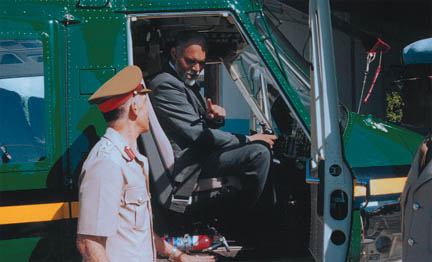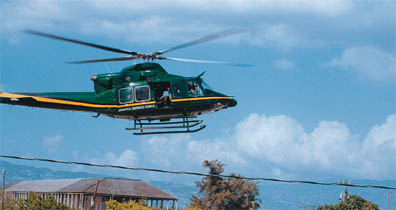|
|||||||||||||||||||||||||||||||
| Home > Info Centre > Publications > Alert 2000 > ‘SAR Birds’ | |||||||||||||||||||||||||||||||
|
|
Being the duty co-pilot of the aircraft, a recently acquired Bell 412EP (Enhanced Performance), I had already prepared the aircraft for flight and my helmet and gloves were sitting in the armed position in the cockpit. It was 0100 hrs when I walked into the operations room of the JDF Air Wing. Five minutes had past since my pager went off. The first words from the Duty Officer were ‘Go Fast’. Immediately I knew we were going out to sea. Shortly thereafter the Aircraft Commander and the crewman arrived. The situation at hand was that the United States Coast Guard had been tracking an unidentified vessel suspected of carrying illegal drugs from The Bahamas bound for the north coast of Jamaica. The vessel was now situated approximately 60 nautical miles to the north of Jamaica in our territorial waters. Our mission was to intercept the ‘Go fast’ position and follow them to shore. The vessel would be boarded by a team of local anti-narcotics police. A thorough briefing was given by the Aircraft Commander and we commenced the mission. Some 30 minutes later as we flew northbound we saw the lights of the north coast fade to a mere twinkle in the distance. The only contact we would have with Jamaica for the next two hours or so, would be by HF radio. We had a while yet before reaching the operational area and as the four axis auto-pilot maintained control of the helicopter, the Aircraft Commander monitored our flight profile and I monitored all four of our radios ranging from VHF to FM, UHF and HF.
The night was getting darker, and darker as we passed through the occasional rain shower and cloud. A night like this would make flying extremely challenging and dangerous in the days gone by. My heart started to fill with pride, as I had been given the opportunity to be a part of the future and this aircraft was definitely part of the future with its endless possibilities. As a successor to the Bell 212, which was a basic twin-engine, two bladed troop transport utility aircraft, capable of carrying three crew and twelve passengers, the Bel1 4l2EP was first developed in the early 1970s. Over the years as the state of helicopter technology progressed and the roles of the helicopter became increasingly diverse, search and rescue (SAR) and surveillance roles started to dominate, leading to the rapid development of the Bel1 4l2. The Bell 412EP features upgraded engines for better performance in hot and humid climates, a low maintenance four bladed rotor, a rigid main rotor system which gives a faster and smoother ride, a hoist for search and rescue operations, a forward looking infra-red camera and crew monitors for surveillance and search and rescue operations. For the pilots, the cockpit features dual electronic flight instrument system (EFIS) displays, a weather radar, a flight management system (FMS) for navigational purposes and a four axis auto-pilot system, which allows for complete hands off flying, and hovering for search and rescue operations. The move from an old to a new fleet in the JDF Air Wing, with the recent acquisition of the Bell 412EP’s, has been significant, and calls for a different breed of pilot. The pilots that command these state-of-the-art aircraft are computer literate and highly trained in cockpit/crew resource management. This allows the pilots to operate the aircraft to their fullest capabilities which will secure for the JDF Air Wing a place in the new millennium.
|
||||||||||||||||||||||||||||||
|
|
|||||||||||||||||||||||||||||||

 I awoke quite hastily at the
sound of my pager, rolled out of my bed into my flying suit and out the door, all in one
motion. My car took me to the Air Wing, while I found my bearings. I thought to myself
"where would my mission take me tonight?." I was sure to find out from the Air
Wing Duty Officer.
I awoke quite hastily at the
sound of my pager, rolled out of my bed into my flying suit and out the door, all in one
motion. My car took me to the Air Wing, while I found my bearings. I thought to myself
"where would my mission take me tonight?." I was sure to find out from the Air
Wing Duty Officer.  It would be a
while before we reached the operational area and as I completed my cockpit checks and
glanced over the array of lights and screens which made up this ‘glass cockpit’ aircraft,
I reflected on my days as a young Bel1 212 co-pilot. I thought, " it was not long ago
that with the old Bell 212, this mission would have been pushing aircrews to their limits.
Bell 212 pilots would have had to hand fly the aircraft out to sea, relying on headings
and timings plotted on a map, cross referenced with a single Global Positioning System and
no weather radar". I now sat in a machine with indefinite capabilities and resources,
reinforced with a very able crew.
It would be a
while before we reached the operational area and as I completed my cockpit checks and
glanced over the array of lights and screens which made up this ‘glass cockpit’ aircraft,
I reflected on my days as a young Bel1 212 co-pilot. I thought, " it was not long ago
that with the old Bell 212, this mission would have been pushing aircrews to their limits.
Bell 212 pilots would have had to hand fly the aircraft out to sea, relying on headings
and timings plotted on a map, cross referenced with a single Global Positioning System and
no weather radar". I now sat in a machine with indefinite capabilities and resources,
reinforced with a very able crew.